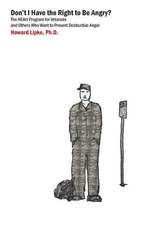Handbook of Item Response Theory: Three Volume Set: Chapman & Hall/CRC Statistics in the Social and Behavioral Sciences
Editat de Wim J. van der Lindenen Limba Engleză Hardback – 25 ian 2018
A full update of editor Wim J. van der Linden and Ronald K. Hambleton’s classic Handbook of Modern Item Response Theory, this handbook has been expanded from 28 chapters to 85 chapters in three volumes. The three volumes are thoroughly edited and cross-referenced, with uniform notation, format, and pedagogical principles across all chapters. Each chapter is self-contained and deals with the latest developments in IRT.
| Toate formatele și edițiile | Preț | Express |
|---|---|---|
| Paperback (3) | 503.22 lei 6-8 săpt. | |
| CRC Press – 15 apr 2019 | 503.22 lei 6-8 săpt. | |
| CRC Press – 4 feb 2019 | 513.32 lei 6-8 săpt. | |
| CRC Press – 7 feb 2019 | 562.96 lei 6-8 săpt. | |
| Hardback (2) | 856.85 lei 6-8 săpt. | |
| CRC Press – 11 feb 2016 | 856.85 lei 6-8 săpt. | |
| CRC Press – 25 ian 2018 | 2005.83 lei 6-8 săpt. |
Din seria Chapman & Hall/CRC Statistics in the Social and Behavioral Sciences
- 8%
 Preț: 399.11 lei
Preț: 399.11 lei -
 Preț: 356.63 lei
Preț: 356.63 lei -
 Preț: 373.34 lei
Preț: 373.34 lei -
 Preț: 349.02 lei
Preț: 349.02 lei -
 Preț: 371.62 lei
Preț: 371.62 lei - 8%
 Preț: 389.62 lei
Preț: 389.62 lei - 9%
 Preț: 641.03 lei
Preț: 641.03 lei -
 Preț: 360.28 lei
Preț: 360.28 lei -
 Preț: 356.63 lei
Preț: 356.63 lei - 9%
 Preț: 609.86 lei
Preț: 609.86 lei - 9%
 Preț: 641.04 lei
Preț: 641.04 lei - 8%
 Preț: 413.11 lei
Preț: 413.11 lei - 8%
 Preț: 404.91 lei
Preț: 404.91 lei - 9%
 Preț: 1277.83 lei
Preț: 1277.83 lei - 8%
 Preț: 548.32 lei
Preț: 548.32 lei -
 Preț: 463.51 lei
Preț: 463.51 lei - 8%
 Preț: 420.83 lei
Preț: 420.83 lei -
 Preț: 416.22 lei
Preț: 416.22 lei - 12%
 Preț: 312.43 lei
Preț: 312.43 lei - 15%
 Preț: 433.90 lei
Preț: 433.90 lei - 18%
 Preț: 1112.34 lei
Preț: 1112.34 lei - 18%
 Preț: 797.43 lei
Preț: 797.43 lei - 22%
 Preț: 334.14 lei
Preț: 334.14 lei - 15%
 Preț: 620.74 lei
Preț: 620.74 lei - 12%
 Preț: 313.40 lei
Preț: 313.40 lei - 15%
 Preț: 503.22 lei
Preț: 503.22 lei - 12%
 Preț: 312.43 lei
Preț: 312.43 lei - 15%
 Preț: 546.07 lei
Preț: 546.07 lei - 18%
 Preț: 1229.46 lei
Preț: 1229.46 lei - 18%
 Preț: 784.97 lei
Preț: 784.97 lei -
 Preț: 452.53 lei
Preț: 452.53 lei - 12%
 Preț: 312.43 lei
Preț: 312.43 lei - 25%
 Preț: 531.38 lei
Preț: 531.38 lei -
 Preț: 441.20 lei
Preț: 441.20 lei - 25%
 Preț: 883.59 lei
Preț: 883.59 lei
Preț: 2005.83 lei
Preț vechi: 2673.92 lei
-25% Nou
Puncte Express: 3009
Preț estimativ în valută:
383.86€ • 400.25$ • 319.02£
383.86€ • 400.25$ • 319.02£
Carte tipărită la comandă
Livrare economică 21 martie-04 aprilie
Preluare comenzi: 021 569.72.76
Specificații
ISBN-13: 9781466514393
ISBN-10: 1466514396
Pagini: 1500
Ilustrații: 200
Dimensiuni: 178 x 254 x 104 mm
Greutate: 2.94 kg
Ediția:1
Editura: CRC Press
Colecția Chapman and Hall/CRC
Seria Chapman & Hall/CRC Statistics in the Social and Behavioral Sciences
ISBN-10: 1466514396
Pagini: 1500
Ilustrații: 200
Dimensiuni: 178 x 254 x 104 mm
Greutate: 2.94 kg
Ediția:1
Editura: CRC Press
Colecția Chapman and Hall/CRC
Seria Chapman & Hall/CRC Statistics in the Social and Behavioral Sciences
Cuprins
Volume One: Dichotomous Models. Nominal and Ordinal Models. Multidimensional and Multicomponent Models. Models for Response Times. Nonparametric Models. Models for Nonmonotone Items. Hierarchical Response Models. Generalized Modeling Approaches.
Volume Two: Basic Tools. Modeling Issues. Parameter Estimation. Model Fit and Comparison.
Volume Three: Item Calibration and Analysis. Person Fit and Scoring. Test Design. Areas of Application. Computer Programs.
Volume Two: Basic Tools. Modeling Issues. Parameter Estimation. Model Fit and Comparison.
Volume Three: Item Calibration and Analysis. Person Fit and Scoring. Test Design. Areas of Application. Computer Programs.
Notă biografică
Wim J. van der Linden is a distinguished scientist and director of research innovation at Pacific Metrics Corporation. He is also a professor emeritus of measurement and data analysis at the University of Twente. He is a past president of the Psychometric Society and National Council on Measurement in Education (NCME) and a recipient of career achievement awards from NCME, Association of Test Publishers (ATP), and American Educational Research Association (AERA). His research interests include test theory, computerized adaptive testing, optimal test assembly, parameter linking, test equating, and response-time modeling as well as decision theory and its application to problems of educational decision making. Dr. van der Linden earned a PhD in psychometrics from the University of Amsterdam.
Descriere
Drawing on the work of 75 internationally acclaimed experts in the field, this handbook presents all major item response models, classical and modern statistical tools used in (IRT), and major areas of applications of IRT in educational and psychological testing, medical diagnosis of patient-reported outcomes, and marketing research.
Recenzii
"Handbook I is likely to be useful for undergraduate or graduate students who have an interest in pursuing quantitative research in educational and psychological testing, especially with datasets that contain multiple discrete outcomes. Master- and doctoral-level students seeking dissertation topics and doing literature reviews will find Handbook I a valuable resource."
~Edward H. Ip, Wake Forest School of Medicine, Journal of the American Statistical Association
"Based on scores in a battery of questions in Psychometrics, IRT is a paradigm for designing, analyzing, and interpreting the individual's abilities. Volume one describes models that are used in IRT. Basic knowledge of calculus and statistical theory are necessary to understand the contents of volume one. The references are thorough and up-to-date…I enjoyed reading this book. I recommend this book to psychologists, sociologists, statistics and computing professionals."
~Journal of Statistical Computation and Simulation
"Handbook I is likely to be useful for undergraduate or graduate students who have an interest in pursuing quantitative research in educational and psychological testing, especially with datasets that contain multiple discrete outcomes. Master- and doctoral-level students seeking dissertation topics and doing literature reviews will find Handbook I a valuable resource."
~Edward H. Ip, Wake Forest School of Medicine, Journal of the American Statistical Association
"Based on scores in a battery of questions in Psychometrics, IRT is a paradigm for designing, analyzing, and interpreting the individual's abilities. Volume one describes models that are used in IRT. Basic knowledge of calculus and statistical theory are necessary to understand the contents of volume one. The references are thorough and up-to-date…I enjoyed reading this book. I recommend this book to psychologists, sociologists, statistics and computing professionals."
~Journal of Statistical Computation and Simulation
"This handbook presents a huge compendium of models which could be innovative even for specialists in IRT and related applied research. It can definitely be useful for lecturers and graduate students, researchers and practitioners in applied psycho-sociological projects. Actually, it can be useful in much wider than just IRT related area of research, because it describes a large variety of statistical ideas and methods valuable in estimations for many other problems as well."
~Stan Lipovetsky in Technometrics, August 2021
~Edward H. Ip, Wake Forest School of Medicine, Journal of the American Statistical Association
"Based on scores in a battery of questions in Psychometrics, IRT is a paradigm for designing, analyzing, and interpreting the individual's abilities. Volume one describes models that are used in IRT. Basic knowledge of calculus and statistical theory are necessary to understand the contents of volume one. The references are thorough and up-to-date…I enjoyed reading this book. I recommend this book to psychologists, sociologists, statistics and computing professionals."
~Journal of Statistical Computation and Simulation
"Handbook I is likely to be useful for undergraduate or graduate students who have an interest in pursuing quantitative research in educational and psychological testing, especially with datasets that contain multiple discrete outcomes. Master- and doctoral-level students seeking dissertation topics and doing literature reviews will find Handbook I a valuable resource."
~Edward H. Ip, Wake Forest School of Medicine, Journal of the American Statistical Association
"Based on scores in a battery of questions in Psychometrics, IRT is a paradigm for designing, analyzing, and interpreting the individual's abilities. Volume one describes models that are used in IRT. Basic knowledge of calculus and statistical theory are necessary to understand the contents of volume one. The references are thorough and up-to-date…I enjoyed reading this book. I recommend this book to psychologists, sociologists, statistics and computing professionals."
~Journal of Statistical Computation and Simulation
"This handbook presents a huge compendium of models which could be innovative even for specialists in IRT and related applied research. It can definitely be useful for lecturers and graduate students, researchers and practitioners in applied psycho-sociological projects. Actually, it can be useful in much wider than just IRT related area of research, because it describes a large variety of statistical ideas and methods valuable in estimations for many other problems as well."
~Stan Lipovetsky in Technometrics, August 2021


















